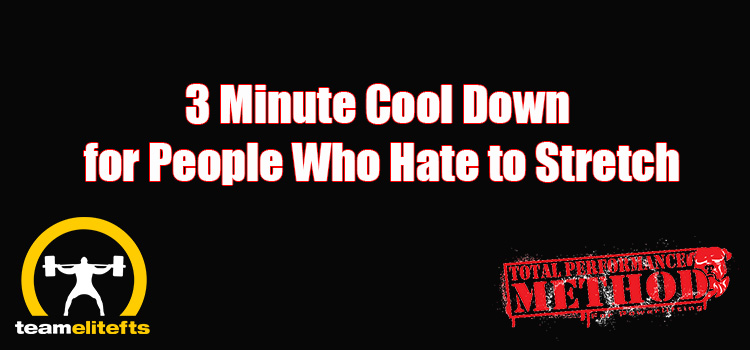
I’ve been doing this a long time and if there is one thing I see a lot, it’s people skipping their cool down after training.
A proper warm up will allow you to train at a higher level with a lower risk of injury and most people realize this and value it.
What they discount is a proper cool down.
Plus, on a large scale, people hate to stretch. Sure, some like it, even love it, but many don’t. And they just don’t do it.
A proper cool down post training does a few things:
- It allows us to get back to a Parasympathetic nervous state rather than leaving the gym all jacked up after training
- It can reduce the risk of injury, cramping and soreness later
- It allows for a gradual lowering of heart rate, blood pressure and respiratory rate
- It can help regulate blood flow post training, especially for endurance athletes
- It can help prevent blood from pooling in the legs
- It can speed recovery
I’m sure I didn’t list all of the benefits of a proper cool down post exercise, but this should be more than enough to convince you it is a good idea, at the least.
Most people view a cool down as static stretching, and while that is a very important component of cooling down, it is not the only thing you can do.
For those who simply hate to stretch, they will not do it and just leave.
BAD IDEA.
But, I have an option.
It’s not going to replace stretching or other forms of a cool down, such as stretching, foam rolling, light walking on a treadmill and others, it is a valuable tool, and it’s quick and easy to do.
For best result, watch the video below, and for those who like to read, I’ll explain it.
I want you to lay on your back with your feet up on a bench or a box in the 90/90 position.
The 90/90 position is hips at 90 degrees and knees at 90 degrees.
Then we are going to breathe.
Yup.
That’s it.
I want you to breathe through your diaphragm for three minutes.
Slow, deep breaths in through the nose and out forcefully through the mouth.
Try to breath so that your belly, NOT YOUR CHEST, rises.
This may take time to get it for some as many of us are chest breathers. For those who have trouble, RPR will help you learn to belly breathe.
Now, remember I said slow breathing?
I mean slow.
I need you to take 6 breaths or less per minute.
It’s not that hard to start at 6 breaths per minute.
Simply inhale for a solid 5 count, and exhale for a solid 5 count. Each breath is 10 seconds long; 6 breaths is 1 minute.
Do this for 18 breaths or 3 minutes (it’s the same if you do it right).
You can add time to this or decrease breaths per minute to progress it.
And before the internet chimes in to crucify me, I am in no way saying this is a replacement for stretching or other forms of cooling down!
I am saying it is a tool that you can use to cool down, and it is 100% better than skipping your cool down.
I’ve got a few clients that absolutely hate to stretch but I make them do this.
They all report that it does indeed work!
If you like to stretch, roll, or do other forms of cool down, try adding this in at the end. I’m willing to bet that you’ll love it.
And, adding in 90/90 belly breathing through the diaphragm will benefit you outside the gym as well.
Yes, even you.
All of you.
So give it a shot.
Did you miss last week’s log?
Oh, yeah, follow us on Instagram too.
@TPSMalden
@tpsmethod
DM ME QUESTIONS THERE TOO!
You might be featured in a Coaching Log
And @tpsmethod
SHARE THIS!
#bostonsstrongest
C.J. Murphy
November 5/2020
Vincere vel mori











